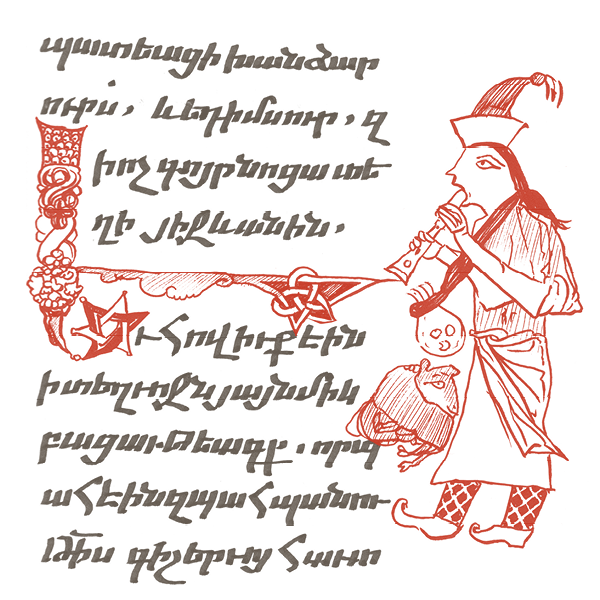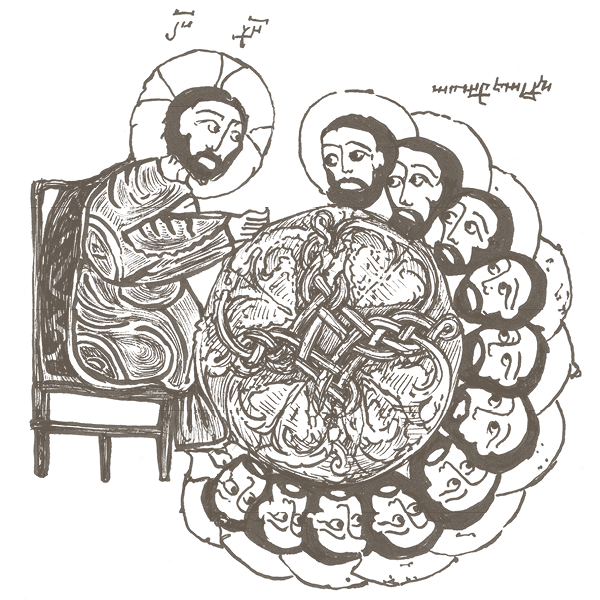Armenian is an Indo-European language spoken in the Caucasus.
Language
| The Lord's Prayer in Classical Armenian (Grabar) Հայր մեր որ յերկինս ես, սուրբ եղիցի անուն քո։ Եկեսցէ արքայութիւն քո։ Եղիցին կամք քո որպէս յերկինս և յերկրի։ զհաց մեր հանապազորդ տուր մեզ այսօր։ և թող մեզ զպարտիս մեր, որպէս և մեք թողումք մերոց պարտապանաց։ և մի տանիր զմեզ ի փորձութիւն։ այլ փրկեա զմեզ ի չարէն։ |
transliteration: |
Among the Indo-European languages, Armenian stands out as one of the most ancient written languages. The earliest monuments of Armenian writing date back to the 5th century when the Armenian script was conceived by the Armenian educator Mashtots in 405 or 406. During the 5th century, the ancient Armenian literary language, known as grabar, underwent complete normalization. In the 12th century, the Middle Armenian language gained prominence, coexisting with grabar and attempting to supersede it in poetry.
Script
Stylistic features of the most ancient writing suggest a connection between the origin of the Armenian script and Greek. It is believed that Mashtots, in creating the Armenian alphabet, drew inspiration from a North Mesopotamian Aramaic script variety that is no longer extant. The order of the letters mirrors that of Greek, with redundant letters following alternately. The Armenian script faithfully represents the vowels of the language, and the sound /U/ is expressed similarly to Greek, through a combination of two signs. While the outlines of the letters bear a stylized resemblance to Greek uncial, the primary similarity lies in the foundational principle of phonetic writing.
The primary challenge in graphic creation lay not in designing individual signs but in accurately determining the phonemic composition of the Armenian language and developing spelling principles. Mashtots' alphabet comprised 36 characters corresponding to the 36 phonemes of the Armenian language. A defining feature of Armenian manuscripts is their graphics and, in the majority of cases, the language itself.
Literature
Grigor Magistros (c. 990-1059) author of The Interpretation of Grammar
Hovhannes Yerznkatsi Pluz (c. 1230-1293) author of the "Collection of Grammatical Interpretations"
Yesai Nchetsi (1260/1265—1338) author of The Definition of Grammar
Arakel Syunetsi (1350-1425) author of “Adam's Book” (1403)
Koriun’s biography of his teacher Mashtots is the first book written in Armenian.
Of the historians of the X century, attention is drawn to: Moses Kagankatvatsi (author of the "History of the Avgans” author of "A brief analysis of grammar").
Thomas Artsruni (historian of the House of Artsruni, one of the most important feudal families of Armenia) and Catholicos John VI (author of the "History of Armenia", brought up to his time).
In the XI century they wrote: Stepanos Taronetsi is the author of The Universal History and its successor Aristakes Lastivertsi.
Of the subsequent historians should be mainly noted:
In the XII century:
— Matthew of Edessa "History" for the period from 952 to 1136, concluding details about the first Crusade
Mkhitar Anetsi - detailed "History" of Armenia
In the XIII century:
— Vardan Bardzyrberdzi (author of the "Universal History", which contains interesting data on the Mongols)
Smbat is the author of the chronographic history of Armenia and Byzantium
since 951 chronographer Mkhitar Hayrivanetsi, Stepanos Orbelian who wrote the "History of the Syunik region"
In the XIV century:
— Hetum, nicknamed the "historian" author of the chronicle for the period from 1076 to 1307
In the XV century wrote: Thomas (Thomas), Metzopetsi about Tamerlane and his successors
Translations into the language
Translations were made not only from Greek and Syriac, traditional for Armenian literature but also from Old French and Arabic. Fragments of the "Canon of Medical Science" by Avicenna (Ibn Sina), the work of Abu Said, and the manual on agriculture "Geoponics", etc. have been preserved.
In the history of Armenian translated literature, the XIV century was marked by a large number of translations of Western European literature. This includes the works of Albert the Great, Nicholas de Lear, Benedict of Nursia, Gregory the Great, Thomas Aquinas, and others
famous authors
A significant contribution to the development of Armenian linguistics was made by Gevorg Skevratsi (XIII — 1301) — the author of 3 works: "Instruction on the Properties of Syllables", "Instruction on Prosody" and "Instruction on the Art of Writing".
According to experts, the works of Aristotle and Plato, translated into Armenian, are most similar to the source.
External links






